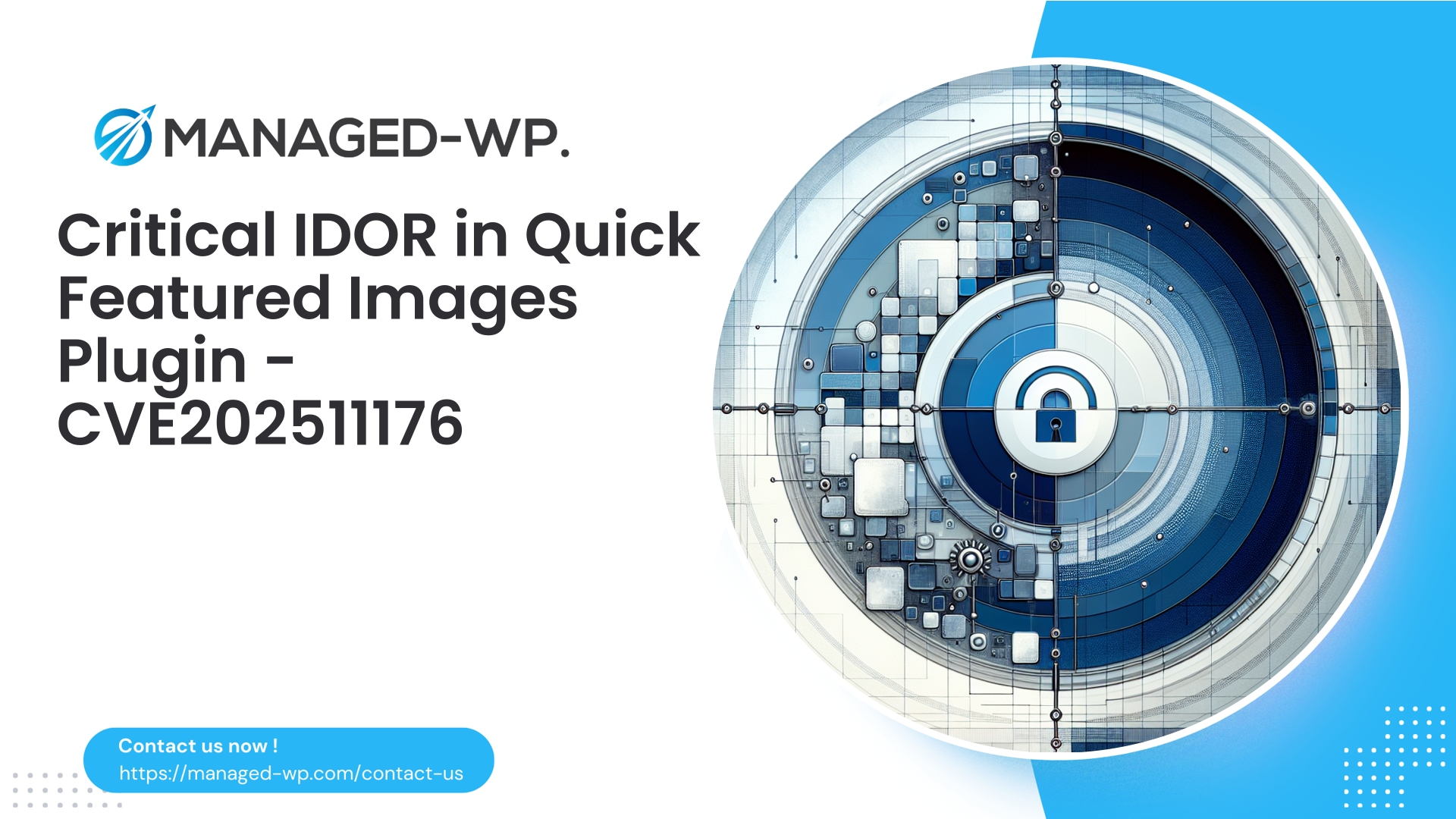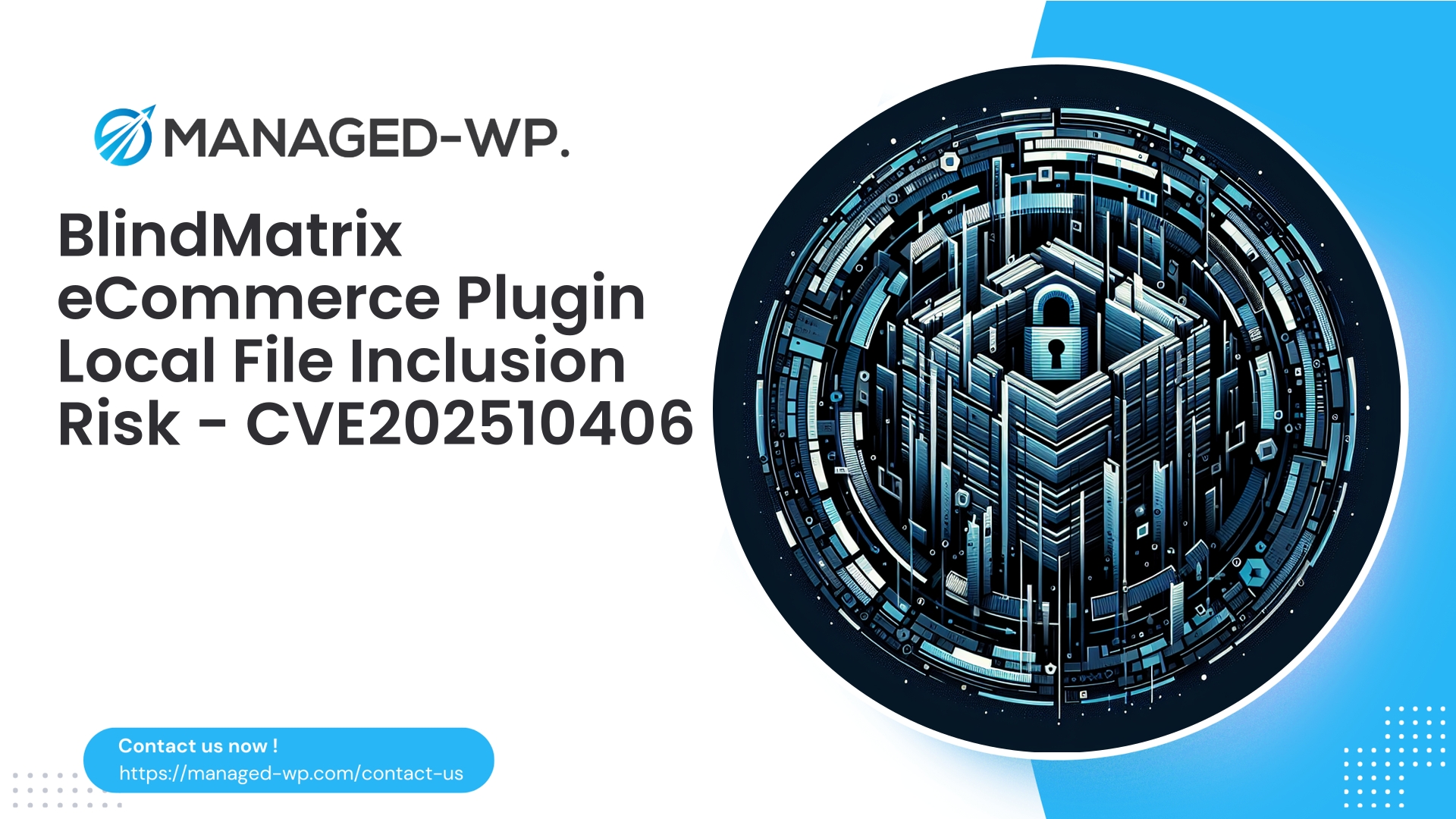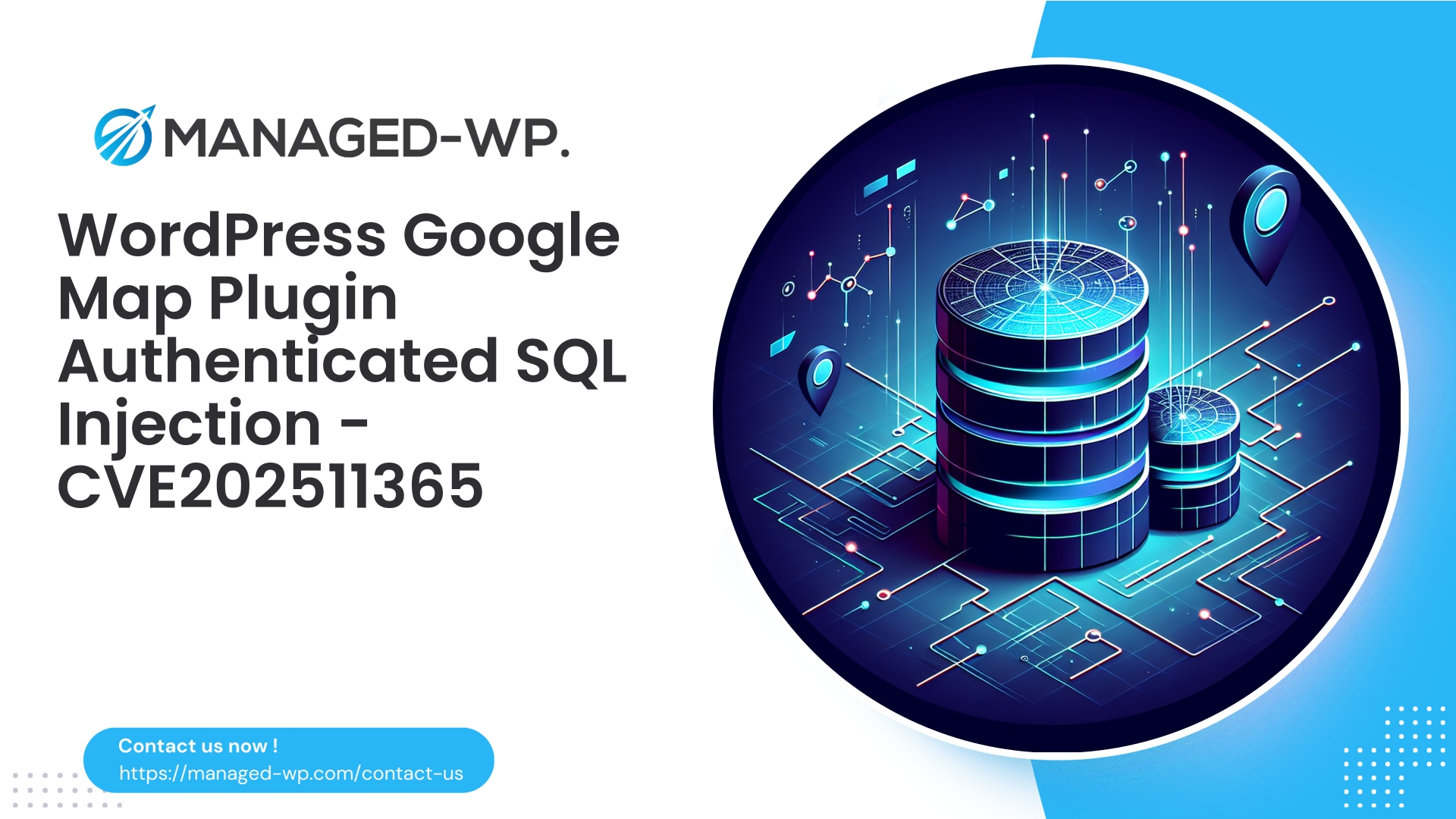| 插件名称 | 快速特色图片 |
|---|---|
| 漏洞类型 | 不安全直接对象引用 (IDOR) |
| CVE编号 | CVE-2025-11176 |
| 紧急 | 低的 |
| CVE 发布日期 | 2025-10-15 |
| 源网址 | CVE-2025-11176 |
快速特色图片 <= 13.7.2 — IDOR 漏洞允许未经授权的图像篡改 (CVE-2025-11176)
由 Managed-WP 安全专家提供
执行摘要: 最近披露的一个低危不安全直接对象引用 (IDOR) 漏洞 (CVE-2025-11176) 影响 Quick Featured Images WordPress 插件的 13.7.2 及更早版本。该漏洞允许具有作者级别权限的已认证用户在其授权范围之外操作图像资源。该漏洞已在 13.7.3 版本中修复。我们强烈建议所有网站运营者立即更新。对于无法快速更新的网站,实施虚拟补丁和额外的安全加固措施可以显著降低风险。
目录
- 事件概述
- 了解 IDOR 漏洞
- 对 WordPress 网站的影响
- 现实世界中的漏洞利用场景
- 剥削迹象和检测方法
- 紧急缓解策略
- WAF 和虚拟补丁如何最大限度地降低风险
- 开发人员推荐的安全实践
- 事件响应检查表
- 针对机构和东道主的规模化补救建议
- 常见问题
- 开始使用托管式 WordPress 安全服务
事件概述
2025年10月15日,安全研究人员发布了CVE-2025-11176漏洞,指出快速特色图片插件(版本≤13.7.2)存在IDOR漏洞。该漏洞的核心问题在于图像处理API端点中的授权检查不足。这使得拥有作者角色或同等权限的已认证用户可以执行未经授权的图像操作。
该漏洞的通用漏洞评分系统 (CVSS) 评级为 4.3,属于低危漏洞。然而,由于它需要经过身份验证的作者级别用户,因此仍然构成实际威胁,尤其是在用户角色分配宽松或启用访客作者功能的网站上。
供应商已在 13.7.3 版本中解决了此问题。我们强烈建议您尽快更新。对于无法立即更新的用户,请遵循以下缓解措施和虚拟补丁指南,以确保您的环境安全。
了解 IDOR 漏洞
当应用程序在未进行适当权限验证的情况下暴露内部引用(例如附件 ID)时,就会发生不安全的直接对象引用 (IDOR) 漏洞。此漏洞使攻击者能够直接访问或修改他们不应该访问或修改的资源。
在 WordPress 中,图像等媒体文件以如下方式存储: 依恋 发布类型通过整数 ID 进行跟踪。安全系统确保只有授权用户(通常是媒体所有者或具有特定权限的用户)才能访问这些内容。 编辑帖子—可以修改这些资源。
在这种情况下,“快速特色图片”功能未能充分验证请求者是否拥有对其所操作的附件 ID 的正确权限,从而允许低级别用户(作者)更改超出其权限范围的图像。
对 WordPress 网站的影响
虽然该漏洞针对的是 Author 角色用户(通常被认为权限较低),但由于以下几个因素,风险仍然很大:
- 许多 WordPress 网站允许客座作者或外包人员投稿,作者可能拥有上传功能。
- 图像处理端点通常与编辑器和客户端工作流程集成,这意味着未经授权的修改可能会影响前端内容和品牌完整性。
- IDOR 可能有助于连锁攻击,例如注入恶意文件或绕过内容清理。
- 即使是低级别的漏洞,如果与薄弱的账户安全措施或其他弱点相结合,也可能导致更广泛的安全漏洞。
现实世界中的漏洞利用场景
潜在影响
- 未经授权的图像更改: 拥有作者权限的攻击者可以替换或修改特色图片,导致图片被篡改或呈现欺骗性内容。
- 恶意软件托管: 攻击者可以通过插入伪装成图像的恶意文件来传播恶意软件或实施网络钓鱼攻击。
- 曝光私人媒体: 未经授权访问与私密帖子关联的附件可能会导致数据泄露。
- 供应链风险: 第三方媒体服务(例如电子邮件、RSS)可能会在不知不觉中传播篡改过的图像,从而扩大影响。
- 声誉损害: 未被发现的图片篡改会损害品牌信任度和搜索引擎排名。
利用前提条件
- 攻击者需要持有(或通过注册或入侵获得)目标网站上的作者级帐户。
利用可能性
- 该漏洞未经身份验证无法公开利用,因此暂时威胁较小。然而,自动化机器人经常扫描低门槛攻击,因此及时修补仍然至关重要。
剥削迹象和检测方法
检查日志是否存在可疑活动
- 分析服务器日志,查找针对图像处理操作的 POST 或 GET 请求,并查找包含以下参数的请求:
attachment_id,post_id, 或者图像 ID. - 注意异常的请求频率或来自意外 IP 地址的访问。
- 识别作者帐户对其他用户拥有的媒体附件进行操作的情况。
WordPress 活动洞察
- 查看附件元数据(文件名、替代文本或标题)是否有大量或突然的变化。
- 监控新添加的媒体文件是否存在异常时间戳。
- 检查管理员通知或内容审核队列,查看是否存在意外的图像修改。
文件系统和恶意软件检查
- 搜索 \`wp-content/uploads\` 目录,查找可疑文件、异常扩展名或不规则命名规则。
- 进行恶意软件扫描,重点关注媒体文件和新增内容。
如果检测到潜在的入侵,请保留详细的日志和媒体文件以进行取证分析,然后按照下面详细介绍的事件响应协议进行操作。
紧急缓解策略
- 更新至最新插件版本
- 立即将 Quick Featured Images 升级到 13.7.3 或更高版本,该版本包含此漏洞的补丁。
- 更新延迟时的临时解决方法
- 如果可以配置,请禁用插件中的图像处理功能。
- 如果这些功能并非必不可少,请暂时停用该插件。
- 限制作者角色的分配;禁用自助注册,并审查用户列表以查找未经授权的作者。
- 重置可疑账户的凭据。
- 采用虚拟补丁和Web应用程序防火墙(WAF)
- 配置 WAF 规则,阻止非管理员角色对映像端点的可疑访问尝试。
- 应用启发式方法来检测异常参数使用或批量附件更改。
- 增强文件系统和上传安全
- 确保上传目录不允许执行 PHP 脚本等代码。
- 在上传过程中实施严格的 MIME 类型验证和文件完整性检查。
- 设置符合最佳实践的正确文件权限(目录:755,文件:644)。
- 连续监测和扫描
- 定期对媒体库内容和审计日志进行恶意软件扫描。
- 及时审查未经授权的请求模式,以防止持续攻击。
- 维护可靠的备份
- 确保有最新的异地备份,以便在必要时快速恢复。
Web应用程序防火墙和虚拟补丁如何最大限度地降低风险
在 Managed-WP,我们实施了强大的多层防御措施,以保护 WordPress 网站免受此类漏洞的侵害:
- 虚拟补丁
- 创建有针对性的 WAF 规则,在攻击到达插件之前拦截攻击尝试,包括阻止对图像处理端点的未经授权访问和强制执行 nonce 验证。
- 虚拟补丁提供即时、无需代码的保护,可以集中部署和回滚。
- 行为检测与速率限制
- 识别可疑的访问模式,例如过多的请求或异常的附件目标,并应用自适应限流。
- 严格的文件上传检查
- 在上传过程中分析文件,检查是否存在危险的有效载荷或不正确的 MIME 类型,以防止恶意文件伪装成图像上传。
- 基于角色的路由过滤
- 在防火墙层通过验证身份验证令牌和角色 cookie 来强制执行基于角色的访问控制。
- 全面的日志记录和警报
- 详细的日志和仪表盘有助于及时发现攻击企图或策略违规行为。
- 托管安全服务
- 对于采用托管计划的客户,我们会迅速在整个网络中推出虚拟补丁,并提供事件补救支持。
笔记: 对于由于暂存或测试限制而无法立即更新插件的环境,虚拟补丁是一种重要的权宜之计。
开发人员推荐的安全实践
维护媒体相关代码的开发人员和集成商应遵循以下最佳实践,以防止出现 IDOR:
- 强制执行能力和所有权检查
- 使用以下方式验证用户权限
current_user_can('edit_post', $post_id)修改资源前,请确认附件所有权。 - 在 REST API 中,实现严格的
权限回调拒绝未经授权请求的功能。
- 使用以下方式验证用户权限
- 对输入数据进行清理和验证
- 利用
intval()对于数字 ID 和sanitize_text_field()对于字符串,避免使用不可信的原始输入。
- 利用
- 验证状态改变操作中的随机数
- 实施
wp_verify_nonce()始终支持管理员 AJAX 和表单提交。
- 实施
- 避免使用客户端信任进行授权
- 所有权和授权问题完全在服务器端解决,避免依赖客户端数据。
- 利用 WordPress 媒体 API
- 使用类似这样的功能
wp_get_attachment_metadata和wp_update_attachment_metadata采用适当的检查方式,而不是直接进行文件系统操作。
- 使用类似这样的功能
- 基于角色限制权限
- 实施更严格的控制,只有编辑或管理员才能执行敏感图像操作。
- 采用综合测试
- 包含单元测试和集成测试,以验证权限强制执行情况以及针对低权限用户尝试执行特权操作的极端情况。
事件响应检查表
- 保留关键日志
- 保护 Web 服务器、WordPress 活动和 WAF 日志,以支持取证调查。
- 隔离受影响的系统
- 分析期间,将受损或可疑系统离线或显示维护模式。
- 应用补丁或停用插件
- 如果无法安全应用补丁,请立即更新快速特色图片或停用该插件。
- 运行全面扫描
- 执行全面的恶意软件和文件完整性扫描,以识别感染或未经授权的更改。
- 重置凭据
- 更改受影响用户的密码,并轮换与您的网站集成的 API 或服务的密钥。
- 从已知良好的备份中恢复
- 如果怀疑存在持续入侵,则回滚到可疑活动之前的干净备份。
- 保持强化监测
- 事件发生后至少 30 天内,加强记录和审查工作。
- 按要求记录和报告
- 遵守有关违约通知的法律和合同义务,并保存完整的事件记录。
针对机构和东道主的规模化补救建议
对于管理多个 WordPress 网站的专业人士,请遵循以下结构化计划:
- 库存插件安装
- 使用 WP-CLI 或管理工具自动进行跨环境的版本检查。
- 优先部署高风险项目
- 重点关注允许外部人员创建作者角色或拥有广泛共享媒体的网站。
- 协调补丁实施
- 对于简单的站点,请立即安排更新。对于复杂的环境,请先应用 WAF 虚拟补丁,并在进行全面测试后再进行插件升级。
- 与利益相关者进行有效沟通
- 用清晰、令人安心的语言告知客户漏洞详情、补救措施和时间表。
- 部署自动化缓解措施
- 通过集中式防火墙部署虚拟补丁规则。监控其有效性并进行调整以减少误报。
- 补丁后审核
- 插件更新后,检查媒体库和日志,以检测任何异常情况。
常见问题
问:由于该漏洞需要 Author 帐户,它是否仍然危险?
答:当然。作者角色通常是自动创建的,或者由编辑为特邀撰稿人创建的。此类账户一旦被盗用或滥用,就可能导致恶意攻击。
问:无需登录即可利用此漏洞吗?
答:不,需要以作者或同等角色进行身份验证。虽然这比未经身份验证的攻击降低了风险,但仍然存在严重风险。
问:更新后,我还需要做其他事情吗?
答:是的。仔细检查媒体库是否存在可疑更改,查看用户日志,如果您部署了虚拟补丁,只有在确认更新完全解决问题后才能将其删除。
问:使用WAF是否会干扰正常的组织功能?
答:WAF 规则配置错误会导致误报。Managed-WP 经过严格的测试,包括模拟和分阶段部署。如果您自行运行 WAF,请先在测试环境中测试更改。
开始使用托管式 WordPress 安全服务
使用 Managed-WP 的专家级安全解决方案保护您的 WordPress 网站。我们的服务包括:
- 全面的托管防火墙和Web应用程序防火墙(WAF)保护
- 实时请求检查,带宽无限制
- 恶意软件扫描侧重于媒体和代码完整性
- 针对包括IDOR和图像篡改漏洞在内的主要安全风险,采取主动缓解措施
立即注册即可享受我们的免费基础套餐,该套餐提供必要的保护措施,在您进行修补和审核时保护您的网站安全:
https://my.wp-firewall.com/buy/wp-firewall-free-plan/
如需自动清除恶意软件、精细化 IP 控制、详细安全报告和自动虚拟补丁等更高级的功能,请考虑升级到我们的标准版或专业版套餐。
最终建议:网站所有者应立即采取的行动
- 立即将 Quick Featured Images 升级到 13.7.3 或更高版本。
- 请在 2025 年 10 月中旬左右审核您的媒体库和日志,以发现异常活动。
- 如果更新延迟:
- 停用该插件或禁用其图像处理组件。
- 限制创建作者角色,并仔细审核现有用户。
- 配置您的WAF以阻止未经授权的附件操作。
- 执行全面扫描并确保有可靠的备份。
- 考虑使用 Managed-WP 的安全服务,以获得持续保护和快速事件响应。
如果您需要专家协助验证您的环境、审查可疑活动或部署待更新的虚拟补丁,Managed-WP 安全团队随时准备为您提供支持。我们已帮助数千个 WordPress 网站快速、可靠地关闭了关键的安全漏洞窗口。
注意安全。
托管式 WordPress 安全专家
(CVE:CVE-2025-11176 — 署名研究人员:Lucas Montes (Nirox))



















